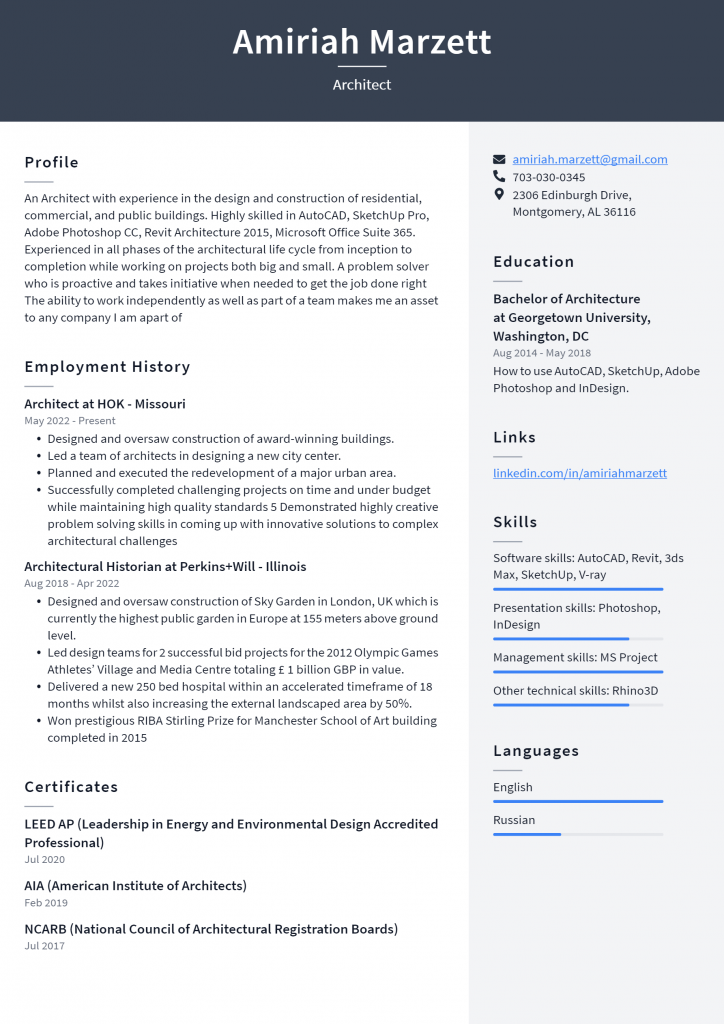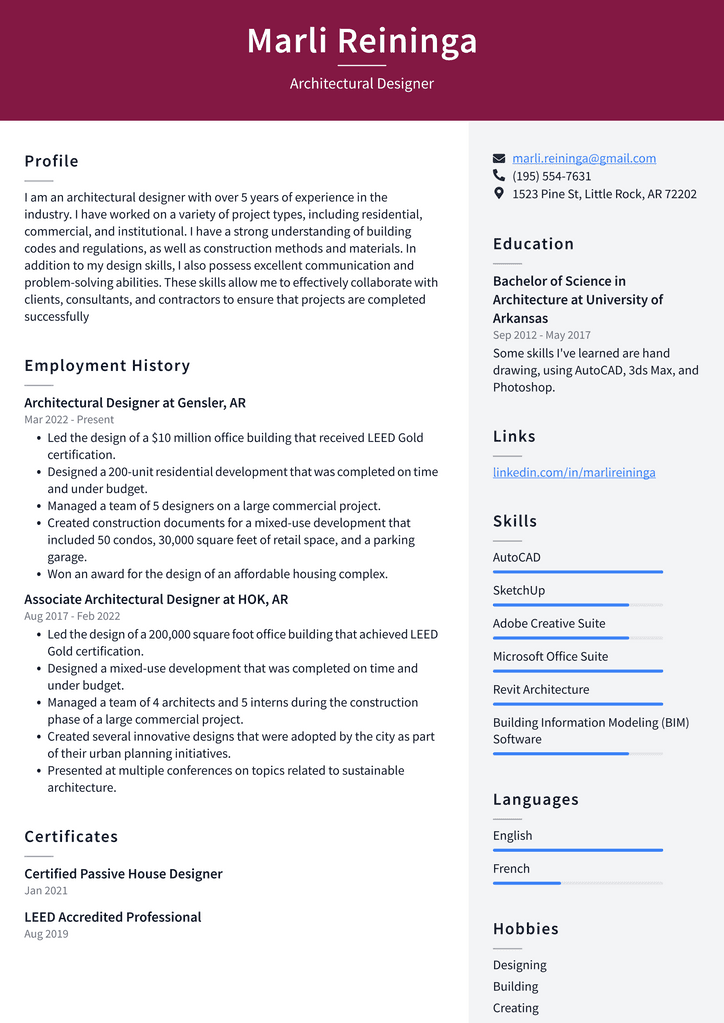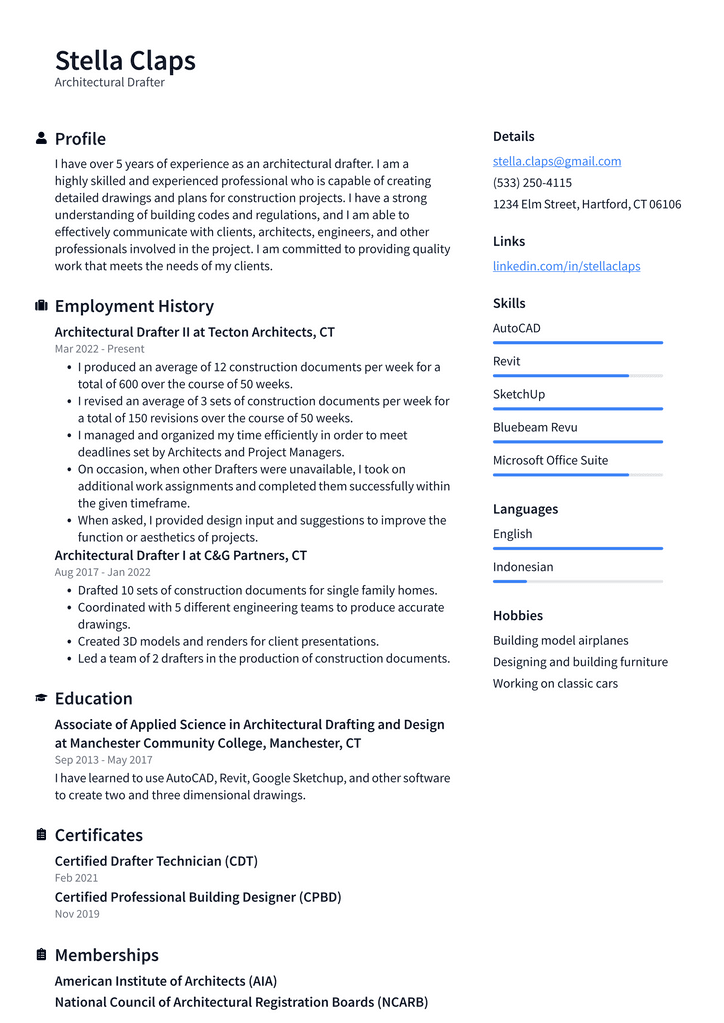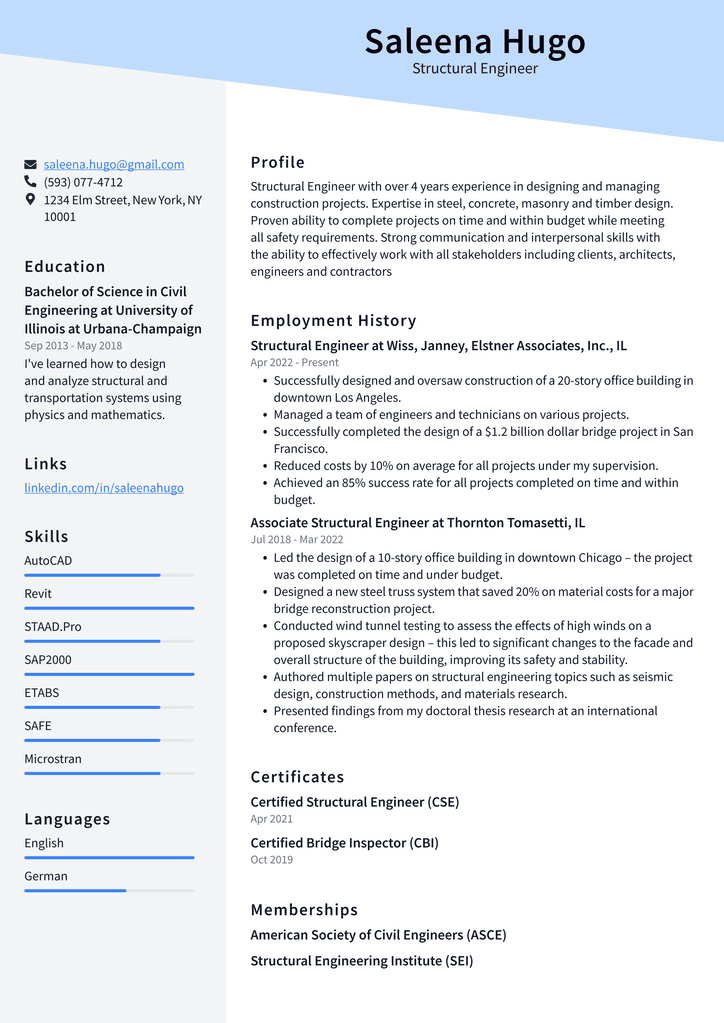Becoming an architect is not easy, so a resume is an essential document that helps you stand out from other candidates. It’s your one-page opportunity to showcase your experience and qualifications for an architecture job. A well-written resume shows hiring managers that you can handle challenging job responsibilities. With this in mind, we suggest you read through our Architect Resume Examples and guide, which will provide tips on tailoring your resume to target specific opportunities. Building an impressive resume requires hard work and dedication, but the result will be worth it when you get called for an interview after the interview! Keep reading to learn more about what recruiters expect from your CV and why – along with helpful tips to create a professional document that will increase your chances of landing the architecture role of your dreams.
Architect Resume Example

Download This Architect Resume as PDF
Architectural Designer Resume Example

Download This Architectural Designer Resume as PDF
Architectural Technician Resume Example

Download This Architectural Technician Resume as PDF
Architectural Drafter Resume Example

Download This Architectural Drafter Resume as PDF
Landscape Architect Resume Example

Download This Landscape Architect Resume as PDF

Download This Naval Architect Resume as PDF
Structural Engineer Resume Example

Download This Structural Engineer Resume as PDF
What to include in an Architect’s Resume?
Before writing, list everything you want to include in your resume. With a clear idea of what to put on your resume, you can focus on how you will format it to capture the attention of hiring managers. We suggest you include the following sections in your resume: – Contact information: List your full name, address, phone number, and email address at the top of your resume. – Summary or objective: This section should describe the work you do and why a company would benefit from hiring you. You can also use this section to summarize your educational and work experience. – Education: List your degrees, honors, and any relevant coursework and internships related to architecture. – Professional experience: This is the most crucial section of your resume, as it is where you describe the type of work you’ve done and the responsibilities you’ve held. You should also include the name of the company where you worked and your job title. – Skills: This is an optional section where you can list computer skills, language skills, and other skills that might be relevant to architecture. – Additional information: This is where you can include any awards or special recognitions you’ve received, civil service appointments, volunteer experience, or any other information you think might be relevant to a job in architecture.
Tips for writing a professional Architect resume
Before writing, list everything you want to include in your resume. With a clear idea of what to put on your resume, you can focus on how you will format it to capture the attention of hiring managers. – Tailor your resume to the job you’re applying for: You want to ensure your resume is targeted to each specific opportunity. This means you want to research the company you’re applying to and tailor your resume accordingly. For example, your resume can include the company’s mission, vision, and products. – Use action verbs: When describing your responsibilities, use action verbs that clearly describe what you did and how you contributed to the company. – Mention your education: You can either mention your degrees or your cumulative GPA in your resume or do both. Make sure to include the name of the college or university and the year you graduated. – Write a summary of your career: If you’ve been in the workforce for a while, you may have difficulty summarizing your experience in a single paragraph. In this case, you can write a summary of your career highlighting the skills and experiences most relevant to the job you’re applying for. – Be concise: One of the biggest mistakes people make is writing an extended essay on their resume. Instead, keep it concise and to the point, focusing on the highlights.
Keywords and synonyms
When writing your resume, use keywords and synonyms whenever possible. For example, if you worked at a software company, you can mention the words “software,” “programming,” and “engineering” in your resume. Using these keywords increases your chances of being found by a computer program that scans and analyzes thousands of resumes. – If you want to be found by human recruiters, make sure your resume includes the names of the companies you worked for, the dates you worked there, and the job titles you held. You can also mention the work you did for each employer to show that you have hands-on experience. – You can also use action verbs and quantify your achievements by listing numbers whenever possible. For example, instead of saying, “I was responsible for managing several projects,” you can say, “I managed six projects with a team of five engineers.” – You want to ensure that your resume reflects your skills. Still, you don’t want to go overboard and list everything you’ve ever done or even every skill you possess. Instead, please keep it to the most relevant skills and experience that show off your strengths and make you stand out from other candidates.
Professional experience section
The professional experience section of your resume should be one of the most detailed sections. In this section, you want to list your most recent experience first (ideally, no more than three positions). At the top of each entry, you should put the employer’s name, followed by your job title, the location where you worked, and the start and end dates of your employment. Next, list your responsibilities, including a detailed description of what you did, the outcome of your work, and the numbers (if possible). This section lets you show recruiters that you have the hands-on experience necessary to succeed in architecture. For example, if you had a long break in your career, you might want to explain the circumstances in a short paragraph at the end of your resume. You can use this space to show that you can handle challenging architecture jobs and have what it takes to succeed in the field.
Education section
The education section of your resume should list the names of the colleges and universities where you studied. You can also include your GPA, but you should only do this if it is very high. Next, you can list any honors or awards you’ve received while studying, the languages you’re fluent in, and any relevant coursework related to architecture. If you took any architecture-related courses as part of your degree, you might want to put them at the top of your coursework list. Most hiring managers are more interested in your work experience than your academic record. Therefore, if you have enough experience, you may not need to list your GPA on your resume.
Conclusion
Your resume is one of the most critical documents in your job search, so you must invest time into writing it well. The best way to do this is by creating a draft and revising it until you are satisfied with the final product. If you follow these tips and keep them in mind while writing your resume, you will be well on your way to creating an impressive document that will get you noticed by hiring managers. Once you have your resume written, make sure also to create a professional cover letter to accompany it. These documents are vital to securing an architecture job, so be sure to put in the time and effort required to make them as strong as possible.